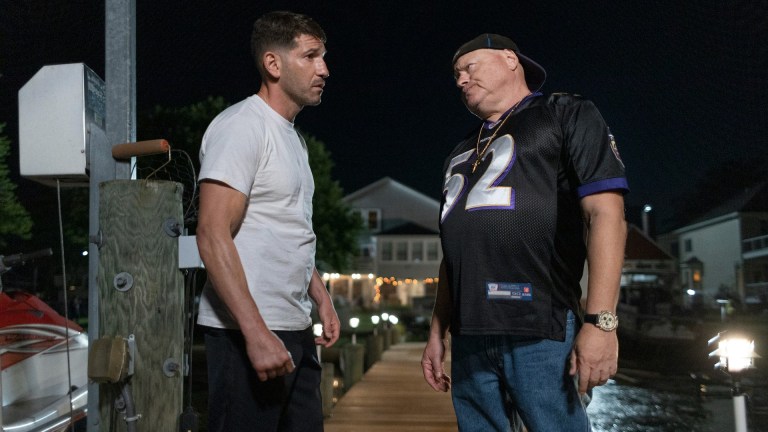We Own This City: How Does HBO Miniseries Compare to The Wire?
HBO miniseries We Own This City is David Simon's most detailed dispatch into the Baltimore law enforcement world since The Wire. How do the two shows stack up?

This article contains only light spoilers for We Own This City.
When The Wire premiered on HBO nearly 20 years ago, it revolutionized the way television could tell a story. David Simon’s crime drama created a world in which we got to see multiple sides to the same person and the institutions they occupy. Cops were seen through the eyes of criminals, politicians were brought to life behind-the-scenes, and even homeless folks were given space to demonstrate their struggles and humanity. The show was a living, breathing diorama of Baltimore projected onto the small screen. There’s never been another show since with so much to say about the setting it’s played out in.
Even though ratings were low during the original run and it didn’t receive any Emmy nominations, new fans and older ones alike have made The Wire one of TV’s ultimate classics. With concepts and ideas about society that are still so relevant today, especially in the world of policing and racism, it’s not shocking that Simon, his usual co-creator George Pelecanos, and the rest of the team decided to revisit Baltimore in HBO’s new miniseries We Own This City.
This time the plot is directly based on the real events that led to the arrests of the men who were part of the Baltimore Police Department’s Gun Trace Task Force, as depicted in Baltimore Sun reporter Justin Fenton’s book of the same name. This takes away some of the creative liberties that the parent show had, as many of these characters are real people and those in The Wire were fictional (though with some real life inspiration mixed in). Still, what the audience wants to know the most is whether this miniseries satiates their craving for the dark, intense storytelling that David Simon’s first show was known for. Let’s discuss!
Familiar Wire Faces Return to the Screen
The number one thing that fans of the original show are going to enjoy the most is the large number of Wire alumni that return to the screen here. Jamie Hector, who played Marlo Stanfield on the original show, is the most notable Wire alum in the cast. He plays a homicide detective in this show, a polar opposite to the street boss Marlo. Other actors that fans should be excited about include Domenick Lombardozzi, who played Herc, and Delaney Williams, who played Jay Landsman.
The issue with these castings is that it doesn’t make up for the fact that the character work in We Own This City is severely lacking compared to The Wire. We don’t get enough time with these characters in six episodes to truly care about their motivations. The return of these actors helps to make the show feel part of Simon’s universe, but they don’t serve a functional role in pushing the narrative along.
Jon Bernthal provides some major heat and intensity in the de-facto lead role of Wayne Jenkins. He’s not one of the alumni above, but he does have experience playing an immoral cop (his iconic portrayal of Shane Walsh in The Walking Dead is still beloved by TV fans). Much like Jimmy McNulty in the original show, Wayne Jenkins is a solid lead, but not the type of character that everyone else can orbit around. The rest of the ensemble is once again crucial to making everything come together.
All Cops, All The Time
The main reason The Wire was such a literary show and so dense with cultural discussion is because it explored more than just one angle of Baltimore. Yes, it was a cops versus dealers show at heart, but there are so many different aspects of society that make up the universe that Simon created. We Own This City doesn’t give you the same wide-ranging discussion that the previous show did. The miniseries uses laser-focus to dissect the major corruption within the Maryland Police Department, and the six hour runtime of the entire story doesn’t leave much room for non-police scenes.
This means that fans of the original show will be treated to much of the same great behind-the-curtain discussions between cops, the same sharp dialogue, and similar morally-ambiguous decisions that are made by the police. What you won’t get is the all-around view of the city of Baltimore that you get in The Wire. Each season of that show built upon the previous one to create a complete picture of the city. You got to see the perspective of politicians, teachers, students, journalists, drug dealers, cops, and more. Each part of the population affected each other in a way that they became interchangeable. Police became teachers and students became drug dealers.
It’s fitting that We Own This City wanted to focus solely on police brutality though considering how prominently the issue looms in 2022. Simon and Pelecanos clearly felt that this time in history is no longer the opportunity to show every perspective. The show leans heavily into depicting its cops as horrible people, demonstrating the ways that even one police officer’s actions build upon others to create the morally inept system that is in place.
One such scene in the third episode shows Officer Jenkins repeatedly punching a man who is simply sitting in front of his own front door. When Jenkins’ colleagues call him out for his violence, it’s not because they are upset at what he did, but rather at him getting caught. The Wire felt a little more like the viewer was able to interpret what they wanted from the show. We Own This City is more like the writers are telling you what to feel. It’s definitely a show that is more of an “in this moment” analysis of policing. It doesn’t feel like it will particularly age as well as its predecessor because of the amount of references to things that happened in the mid-2010s, particularly the amount of times the murder of Freddie Gray brought up by a character.
The Verdict
Every fan of The Wire should at least check out this iteration of Simon and Pelecanos’ work. It doesn’t exactly expand on the universe of the original show, but it lets you into the psyche of the people who made that show. It gives you a new lens to interpret the political coding and the messaging that The Wire uses. That should be good enough for most of the audience.
The final two episodes of We Own This City air Monday, May 23 and Monday, May 30 at 9 p.m. ET on HBO.
